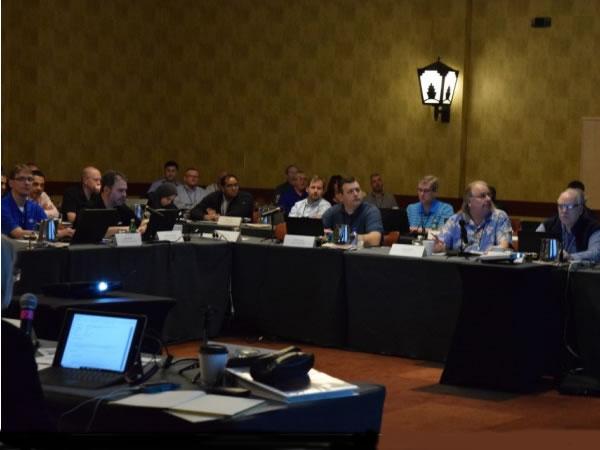
The board meeting took place yesterday, followed by the president’s welcome reception last night. Today kicked off with a meeting of the certification committee.
The Safety Glazing Certification Council
John Kent, president of Administrative Management Systems (AMS), gave an update from the Safety Glazing Certification Council (SGCC), which is developing an online training tool to outline how to run safety tests correctly.
SGCC plans to launch the training tool before its next meeting in October. The council will also consider integrating quality system requirements with existent testing and sampling requirements.
SGCC will also consider further defining laminated specialty products. Simplifying labeling is also on the horizon, based on a response from the U.S. Consumer Product Safety Commission that the current labeling procedures could cover more topics than necessary.
The group is also kicking off a voluntary pilot study to review equivalency of tempered glass and coated tempered glass testing.
The Insulating Glass Certification Council
The Insulating Glass Certification Council (IGCC) will look at which internal components should be tested according to the e2190 series of test standards.
“We’ve been wrestling with guidelines to identify which ones should be tested,” said Kent. “We’re looking at testing worst-case and highest-produced products for grilles, decorative inserts, blinds and the other category.”
IGCC approved a voluntary fingerprint process for sealants. Companies can submit a sample of the sealant to get a chemical fingerprint. Companies will be able to compare the sealant from one year to another or pre- and post-test.
“It will give you a shape of a curve and you can see if something is going on that you might not understand,” said Kent. “Are your materials possibly changing?”
IGCC considered formalizing the corrective action process after a request for root cause analysis upon test sample failures. However, the process was cumbersome and not approved. It’s unclear if the process will be picked up by the council later.
One major challenge the Council is focused on, Kent said, is product equivalency to allow switching between products in the same generic category. Current codes define the three spacer categories as single-material single-function spacers, multi-material single-function spacers and multi-material multi-function spacers.
“What we’re going to do first is gain graphics and descriptions of all the different types of spacer systems, so we know what we’re looking at. We’ll create some sort of equivalency groupings,” said Kent. “Otherwise, fabricators will have to do around a hundred tests a year because nothing’s equivalent. We need to have some things that are reasonably equivalent.”
The Insulating Glass Manufacturers Association of Canada
The Insulating Glass Manufacturers Association of Canada (IGMAC) certification program received a request for the gas content testing of triple-glazed units to be averages across all cavities rather than having the unit fail because one cavity does not meet the requirements.
Sealants
A new task group was created to define test methods for two-part sealants.
Another task group was created to work through some of the challenges of defining tolerances of different spacer systems. Spacers and sealant suppliers were asked to determine how many spacer system categories currently exist.
Design Considerations for Complex Configurations
Roland Rossman of Garibaldi Glass, chair of the certification committee, called for a task group to establish guidelines for design considerations for complex insulating glass units (IGU), which includes oversized glass.
“Fabricators need to come on board and help to set up some type of framework. It’s real and it’s coming,” said Rossman. “We see people asking for particularly large units. There are risks and liabilities involved in creating oversized glass.”
“IGMA is about being proactive instead of reactive,” added Margaret Webb, executive director of IGMA.
The committee voted to create a task group to create a scope to develop design considerations for oversized IGUs.

